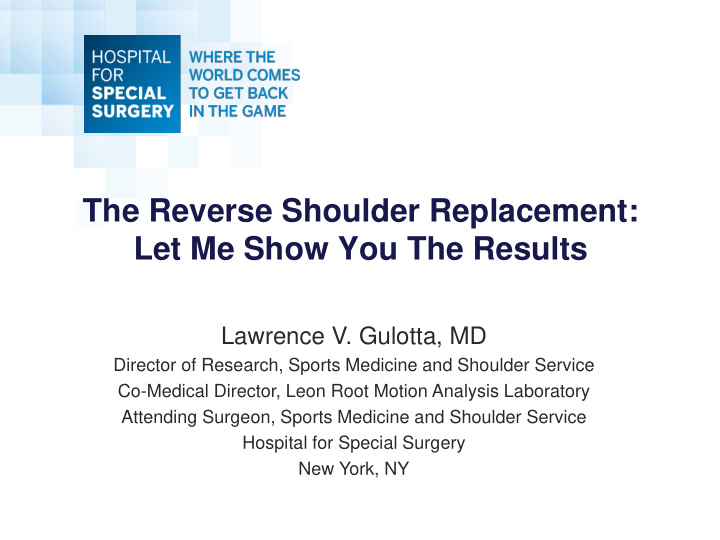



The Reverse Shoulder Replacement: Let Me Show You The Results Lawrence V. Gulotta, MD Director of Research, Sports Medicine and Shoulder Service Co-Medical Director, Leon Root Motion Analysis Laboratory Attending Surgeon, Sports Medicine and Shoulder Service Hospital for Special Surgery New York, NY
Disclosures Consulting and speaking fees from Zimmer-Biomet, Inc
Great Advances for Mankind
Most People Would Consider Putting Something in Ass Backwards a Mistake, Not a Revolution What is a Reverse Shoulder Replacement? Why Does it Work?
Shoulder Biomechanics 101 Courtesy of Andreas Kontaxis, PhD
Shoulder Biomechanics 101 Courtesy of Andreas Kontaxis, PhD
Cuff Deficient Shoulder Escape
NEED STABILITY!! RSA works because it is semi-constrained -> STABLE Courtesy of Andreas Kontaxis, PhD
Cuff Deficient Shoulder Charles Neer’s Experience Anatomic Arthroplasty in Cuff Deficient S houlder - Reduced Pain - Did not Improve Function - “ Limited Goals”
Cuff Deficient Shoulder Need more constraint to improve function Mark I Mark III • High Glenoid Failure Rates • Large moment arm created shear • Poor fixation Neer. S houlder Reconstruction. 1990
Birth of the Modern RSA Paul Grammont, Lyon France, 1980’s Constrained shoulder with medialized center of rotation Converts shear forces to compressive forces across glenoid implant – bone interface
Birth of the Modern RSA 1. It works because it is more constrained, stable. 2. Clinically viable because reversing the anatomy allowed medializing the COR which limited glenoid failures
Expanding Use of Shoulder Arthroplasty • Kim et al. JBJS 2011
Expanding Use of Shoulder Arthroplasty Worldwide: 50% Reverse Europe: >50% Reverse
Expanding Use of Shoulder Arthroplasty - Cuff Tear Arthropathy - Fractures - Nonunion, malunions - Revisions - Irreparable Rotator Cuff Tears - OA with “Dysfunctional Cuff” - OA with Glenoid Bone Loss
Expanding Use of Shoulder Arthroplasty Cuff Tear Arthropathy - #1 Indication - 73 y/o RHD female with right shoulder pain. - FF 70, ER neutral, IR to back pocket
Expanding Use of Shoulder Arthroplasty 6 Weeks Post-op RS A
Results
Outcomes of RSA French Tampa 93% S atisfied AS ES 33.3 -> 75.4 Constant 23 -> 60 Boston 90% S atisfied S S V 26% -> 77% Primary, 62% Revision
Outcomes of RSA - Take home from several studies: - Validated shoulder scores in the 70’s - Effective for pain relief - ROM - FF – 140 Constraint Allows for S tability - ER – 10 But Limits Motion - IR – Back pocket - Satisfaction in 90% of patients - These are not normal shoulders - Complications…...
Complications Some reports as high as 50% (Gerber, HSS) – Hematoma – Notching – Acromion stress fracture – Baseplate failure – Periprosthetic fractures – Neurologic injury – Deltoid origin pain – Infection
Complications Primary: 13.4% Revision: 33.3%
Complications – My Experience First 500 RSA’s Overall Complication Rate: 9.0% (45) –Revision Arthroplasty: 16% –Primary Arthroplasty: 6.6% •Persistent Pain/Stiffness – No Obvious Cause (31) •Instability (5) •Nerve Injury (3) •Acromial Stress Fracture (3) •Infection (3) Comparable to Anatomic TS A
My Experience Complications by Year 30% 25% 50 RS A ’s 20% 15% 10% 5% 0% Year 1 Year 2 Year 3 Year 4 Year 5 Year 6
Outcomes of RSA We know that about 90% of patients will be satisfied What does it mean to have a shoulder that is 70-75% of normal????
Outcomes of RSA - Doc, after surgery, can I: - Golf? - Swim? - Perform my ADL’s? - Go back to work?
Outcomes of RSA After RS A - 85% went back to recreational activities - Average of 5 months post - op - #1 Complaint: Can’ t put arm behind back
Clinical Studies Can We Predict Outcomes Following RSA?
Clinical Studies Can We Predict Functional Outcomes? - PROMS - Registries MCID for TS A and RS A was 9 points for AS ES score S CB for RS A was 23 points on AS ES - Patients who failed to reach MCID - Higher baseline MCID - RS A not as likely to reach MCID as TS A
Clinical Studies Predictors of Poor Outcomes - Men - Intact RC - High Baseline AS ES Final AS ES 75 S ame for both groups
Relativity There is a ceiling effect with RSA RSA tops out at: - FF 140 - Functional scores 70’s - Constraint a blessing and a curse Reality (Outcome Scores) – Expectations = Satisfaction
Conclusions RSA indications and utilization continue to expand Solution to a problem that vexed surgeons for decades Only reliable solution to true mechanical pseudoparalysis Constraint provides stability, but also prohibits normal motion There is a ceiling effect with outcomes Rotation is particularly limited
Thank You
Recommend
More recommend